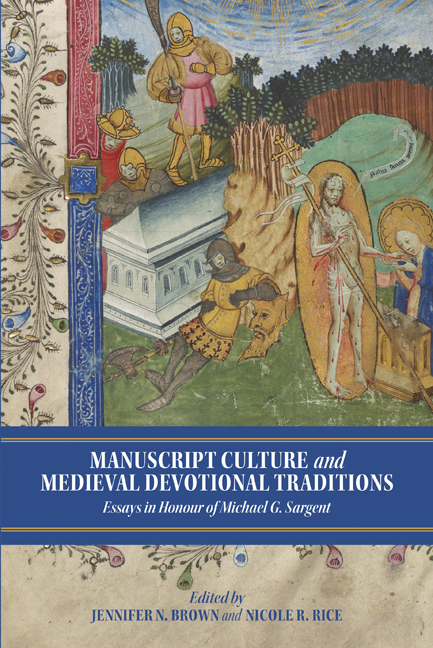Book contents
- Frontmatter
- Dedication
- Contntes
- List of Illustrations
- Acknowledgements
- List of Abbreviations
- Michael Sargent: An Appreciation
- I Manuscript Transmission and Textual Adaptation
- II Translated Texts and Devotional Implications
- III Rhetorical Strategies and Spiritual Transformations
- IV Texts and Contours of Religious Life
- Bibliography
- List of Contributors
- Michael G. Sargent’s Publications
- Index
- Tabula Gratulatoria
- York Manuscript and Early Print Studies
8 - ‘Trowes þou, fool, þat þis kake of brede is God?’: Spiritual Bread and Bodily Meat in Middle English Women’s Visionary Texts
Published online by Cambridge University Press: 24 March 2021
- Frontmatter
- Dedication
- Contntes
- List of Illustrations
- Acknowledgements
- List of Abbreviations
- Michael Sargent: An Appreciation
- I Manuscript Transmission and Textual Adaptation
- II Translated Texts and Devotional Implications
- III Rhetorical Strategies and Spiritual Transformations
- IV Texts and Contours of Religious Life
- Bibliography
- List of Contributors
- Michael G. Sargent’s Publications
- Index
- Tabula Gratulatoria
- York Manuscript and Early Print Studies
Summary
Introduction: ‘sacramentale commemoracion’ in female mystical writings
A select group of female visionary writings were brought to the late medieval vernacular audience in fifteenth-century England, disseminated from monastic sources but not confined to those communities. In addition to the revelations of Bridget of Sweden, Catherine of Siena and Mechthild of Hackeborn translated and adapted in a number of Middle English manuscripts, some lives of holy women were also translated into Middle English in the period. These vitae include the accounts of the béguines Elisabeth Spalbeck, Marie of Oignies and Christina Mirabilis and a long missive describing the life of their non-béguine sister Catherine of Siena, in Oxford, Bodleian MS Douce 114; and the lives of Catherine of Siena and Elizabeth of Hungary in Cambridge, C.U.L., MS Hh. I. 11. While these texts offer orthodox teachings on a variety of devotional practices and spiritual beliefs, the original scribes and confessors all highlighted the act of communion as integral to the spirituality of these women.
After the Berengarian heresy, eucharistic doctrine in thirteenth-century medieval Europe solidified due to the Fourth Lateran Council's decrees about transubstantiation and Aquinas's influential eucharistic arguments in the Summa Theologica. Gerhard Lutz argues that the strengthening of eucharistic doctrine resulted in a greater concern by laypeople and religious in the eucharist and the Corpus Christi cult, starting in Germany and the Low Countries and then spreading outwards in the fourteenth century: he notes that the mid-fourteenth century ‘marks a turning point in late medieval eucharistic veneration when the movement apparently gained a socially broader momentum’. During this period in continental Europe accounts of béguines and the revelations of certain female visionaries paid special attention to communion and fasting practices, visionary experiences that take place during communion and visual metaphors that represent transubstantiation. These women and their practices made the invisible visible and described in literal, visual terms the transformation of bread and wine into the body and blood of Christ.
By the time these texts were being translated into English John Wycliffe's challenge to the doctrine of substantiation had changed the landscape in England of scholastic debates about the real presence of Christ in the host.
- Type
- Chapter
- Information
- Manuscript Culture and Medieval Devotional TraditionsEssays in Honour of Michael G. Sargent, pp. 179 - 199Publisher: Boydell & BrewerPrint publication year: 2021

